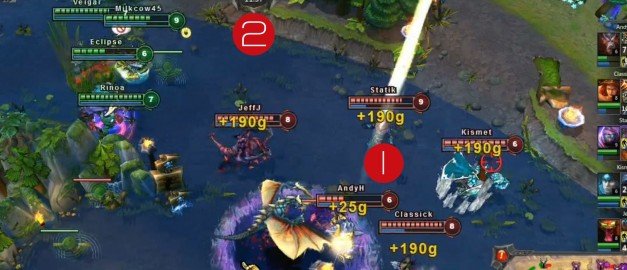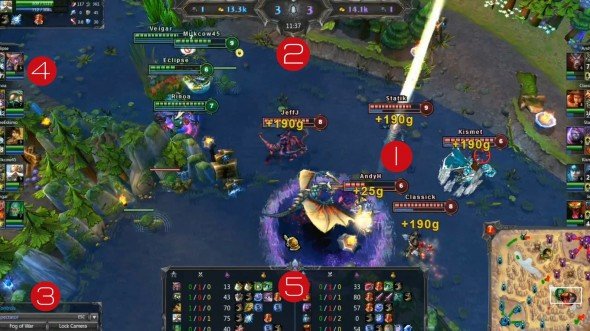The full breakdown on League of Legends' Spectator Mode

See, not every piece on League of Legends involves new champions! Riot Games has been working diligently behind the scenes on the highly-demanded Spectator Mode, and it has just about polished it to perfection. Josh and I got to witness Spectator Mode in action at E3, and the demonstration left us with zero complaints or wants—it seems Riot thought of everything. Read on to check out a detailed deconstruction of Spectator Mode's various features.
Now, this isn't a repackaging of the Observer Mode that you've likely seen in previous LoL tournaments or shoutcasts. The previous rendition felt more like a workaround, where the observer would be listed as a teammate to one side, only able to keep tabs on one team's perspective. Riot's addressed this problem, and how—spectators will now be on an entirely separate "team" of their own, able to chat amongst themselves as they watch the action unfold. Producer Travis George emphasized that the name change from Observer to Spectator was a calculated decision, saying that watching high-level LoL players needs to feel "more like a sporting event." PR Manager Chris Heintz added that Spectator Mode should feel "as close to ESPN as possible." (Minus the obnoxious Around the Horn episodes, I presume.)
And it's not just in-game improvements, either: Riot plans to revamp the website to draw attention and drum up excitement for major and minor tournaments alike. Plans are in place to include a live bracket for tournaments as part of the new page's coverage, and George stated that they want to support shoutcasting as much as humanly possible. One way to do that is by giving spectators some empowering interface functionality, with a new UI made specifically for Spectator Mode. Want to get the skinny on how it'll work? Let's take a closer look and break it down, piece by piece.

1: Visibility
No longer is the audience restricted to watching one team or the other—spectators will be able to see every player, not to mention the entire map. That also includes being able to see when members from either team get gold from creep kills, towers, and so on. Now it'll be apparent who's dominating a lane, and who's lagging behind on CS.
2: Readability
This handy scoreboard isn't fully finalized, but we like what we see already. The biggest numbers in the middle display how many kills each team has, and this is usually (but not always) a good indicator of who's in the lead. On the outsides, there's a display for how many buildings a team has destroyed—again, pretty self explanatory. What's most interesting is the number in between: this denotes how much gold either team has earned as a whole. While it may not be as exciting as a killing spree, a team's gold count is oftentimes the best determinant of how much it's leading or losing by. As you can see in the example here, the kill tallies may be the same, but Purple's gold is ahead by a sizable margin, meaning it can afford more items that grant additional damage and survivability.
The biggest gaming news, reviews and hardware deals
Keep up to date with the most important stories and the best deals, as picked by the PC Gamer team.
3: Super-vision
As you can see from this little side panel in the corner (which got cut off in the image by Riot—curses!), spectators can control their map awareness, so to speak. Fog of War can be toggled on or off to see if a player did or didn't notice that an entire team was about to gank him, and one team's perspective can be chosen for a throwback to Observer mode. Best of all, custom hotkeys allow spectators to move the camera at the press of a button. In the build we saw, George had mapped the members of the Blue team to Q, W, E, and R, and with just a few keystrokes, he zipped around the map, switching to ongoing action instantly and able to lock his camera on whichever champion struck his fancy. George said this tool will be a huge boon to the shoutcasting community—mastery of your keybindings will be incredibly liberating for commentators and spectators alike, as commentators will be able to control where, when, and how we view the action.
4: Primed and ready
Just like when you're playing the game, you'll see a row of portraits displaying the HP and MP levels of your teammates, and whether or not their ultimate abilities are ready for use. But what you won't see anywhere other than Spectator Mode are the cooldowns for each Summoner Spell a champion's selected. This means you can cringe when someone gets ganked two seconds before their Flash was up, or yell at your monitor when Ashe fails to use her ultimate in a teamfight even when it was available the entire time. If you want even more in-depth info, you can click on a champion's portrait to see the cooldown on their every ability, and what level each of their skills is at.
5: The nitty-gritty
And, of course, you've got a complete picture of what's happening in the game at the bottom of the screen, with the same information you'd normally see if you pressed Tab to check the scoreboard during a real match. This isn't incredibly exciting, but it is quite useful—at a glance, you can see who's getting which items, who's not killing enough creeps, and which champion is feeding like crazy with their 0/11/2 record.
Additionally, George explained that the playback on matches has a slight delay (around 15 seconds) for two reasons: to eliminate the possibility of a phone-a-friend cheater who tells you where everyone is, and to reduce stress on the already crowded servers. So there you have it: Spectator Mode, the new best way to watch your favorite League of Legends matches (that's almost a game within a game, thanks to the spiffy camera macros). At the moment, Spectator Mode is only compatible with custom games—this will likely change, but it's fine for now, as all championship matches are set up as customs. George said they would try to deliver Spectator Mode to fans as soon as possible after DreamHack, where they'll be showing off its capabilities for the entire audience to see.
Speaking of DreamHack, get hype! This weekend, the best League of Legends players around will be duking it out for an unprecedented $100,000 prize pool at DreamHack 2011 in Jönköping, Sweden. You should definitely check out the LoL page dedicated to DreamHack periodically during the weekend—I know I'll be glued to my seat for these matches, where we'll get to witness the titans of the LoL community clash for fame and fortune. Which community will be victorious in the battle of US vs EU servers? Tune in to find out.

